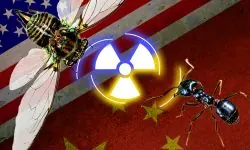Since its very outbreak in March 2022, the geopolitical and economic effects of the war in Ukraine have combined with the cascading consequences of climate change (Jean-Michel Valantin, “War in Ukraine, The U.S Mega drought and the Coming Global Food Crisis”, The Red Team Analysis Society, May 1, 2022). In 2023, it is very likely that this geopolitics-climate nexus will dramatically worsen. This stems from the emergence of what could very well be a turbocharged El Niño event combined with the disruptive effects of the war in Ukraine on global agriculture.
- DeepSeek vs Stargate – China’s Offensive on U.S. AI Dominance?

- Trump Geopolitics – 1: Trump as the AI Power President

- Uranium for the U.S. Nuclear Renaissance – 2: Towards a global geopolitical race

- The New Space Race (1) – The BRICS and Space Mining

- Uranium for the U.S. Nuclear Renaissance – 1: Meeting Unprecedented Requirements

- Fifth Year of Advanced Training in Early Warning Systems & Indicators – ESFSI of Tunisia

- Towards a U.S. Nuclear Renaissance?

- AI at War (3) – Hyperwar in the Middle east

El Niños are cyclical climate-ocean events, which happen when the equatorial Pacific Ocean surface warms up for one to three years. Regularly, those events trigger cascades of extreme climate events all around the world. The previous 2016 El Niño has been historically powerful. The 2023 El Niño may very well be even more dangerous, because of the rapid worsening of climate change that will very possibly reinforce El Niño’s intensity (Paloma Trascasa-Castro, “Four Possible Consequences of the El Niño Return in 2023”, The Conversation, 26 January 2023).
In other words, the combination of the war in Ukraine and of climate change’s disruptions, especially in the fields of agriculture and food, are driving the massive “return of the repressed”, i.e. the capability of modern societies to meet the basic needs of populations on a rapidly warming planet, or not.
The war in Ukraine and the global fertiliser crisis
2023 and the 2022 fertiliser crisis
In 2022, following the Russian offensive on Ukraine, the economic sanctions adopted by the European Union, the G7, the U.S. and Canada triggered a spike in fertiliser prices (Maxim Suchkov, “Repercussions of Russian sanctions, from agriculture to microchips”, Russia Matters, 10 March 2022 and Atti Domm, “A fertilizer shortage, worsened by war in Ukraine, is driving up global food prices and scarcity“, CNBC, April 6, 2022).
This happened because Russia and Belarus are leading producers of these essential products. The financial sanctions induced important difficulties for Russia and Belarus in exporting their fertiliser production. However, since the 2022 spike, fertiliser prices have been decreasing (Charlotte Hebebrand and Joseph Glauber, “The Russia-Ukraine war after a year: impacts on fertilizer production, prices and trade flows”, International Food Policy institute, March 9, 2023).
2023 as an agricultural danger zone
Throughout 2022 and the first quarter of 2023, facing the disruptions of the global fertilizer trade as well as the impacts of extreme weather events, several countries decided to limit or to ban the export of their own fertilizers production, or of basic components such as potash or urea. This was the case, for example, of China. Big importers, such as Brazil, India, Morocco, had to diversify their imports from other sources, Canada among others. Those systems of disruptions affect more than 20% of the global fertilizers trade (Hebebrand and Glauber, ibid).
This situation decreased the global availability of fertilizers. The most vulnerable countries, especially sub-Saharan countries, had problems to secure imports. This is pushing farmers to use alternate ways to fertilize fields, such as manure (Douglas Broom, “This is how war in Europe is disrupting fertilizer supply and threatens global food security”, World Economic Forum, March 1, 2023. Several international institutions, such as the World Bank, the African Development Bank, the World Food Program stepped in in order to help vulnerable countries importing fertilizers (Jeff Kearns, “Global Food Crisis may Persist, with prices elevated after year of War”, International Monetary Fund Blog, March 9, 2023).
However, diminishing uses of nitrogen and phosphates fertilizers mean high risks of 2023 diminishing crop yields. Trying to offset this risk, many farmers turn away from food crops to cash crops, such as tobacco. This approach is quite dangerous for those farmers, because they become dependent on the global markets prices oscillations (Kearns, ibid).
In the same timeline, Canada, and the U.S. government are strongly supporting the development of their domestic fertilizer production. The problem is that this production is heavily dependent on the prices and availability of fossil fuels (Charlotte Hebebrand and Joseph Glauber, “The Russia-Ukraine war after a year: impacts on fertilizer production, prices and trade flows”, International Food Policy institute, March 9, 2023).
From Germany to India vs fertiliser
This is especially true for Germany, whose chemical production feels strongly the huge impact of the loss of Russian gaz imports, because of the restrictions by Gazprom, the EU sanctions and the strange destruction of the Nord Stream 1 and 2 pipelines (“Germany says no results yet of Nord stream pipe lines sabotage investigation”, Reuters, 7 march 2023, and Thane Gustafsson, The Bridge – Natural gas in a redevided Europe, Harvard, 2020,).
In this context where agriculture, food security and geopolitics intermingle, it is worth noting that, during the September 2022 meeting of the Shanghai Cooperation Organization in Samarkand, the Indian Prime Minister negotiated at length fertilizers imports with the Russian President (Jean-Michel Valantin, “An Excluded Russia? – Not for Asia – Anthropocene Wars 6”, The Red Team Analysis Society, 3 October 2022).
As it happens, the global agricultural tensions that the fertilizer production and trade disruptions induce may very well worsen in 2023, because of the emergence of a massive El Niño climate risk.
A Super El Niño and the overheating of geopolitics?
“Something wicked this way comes!!!”[1]
During an El Niño event, the equatorial Pacific Ocean may heat up to 3°, thus heating up the whole atmosphere. The singular aspect of the 2023-2024 El Niño is that it happens in a time of rapidly intensifying climate change. The atmosphere temperature being already 1.2° above the mid-18th century pre-industrial level, the El Niño peak temperature may very well temporarily heighten the atmosphere’s heat at 1.5°. As it happens, this level is nothing but the upper peak limit of what climate scientists establish as the upper climate security limit (Kate Abnett, “World could face record temperatures in 2023 as El Niño returns”, Reuters, April 20, 2023 and Ajit Niranjan, “How climate change affect El Niño and La Nina cycles?”, DW, 01/27/2023).
As El Niño’s events historically trigger massive climate disasters, such as droughts, floodings, vegetation stress and crop failures all around the world, the 2023-24 one may induce a planetary interaction between a berserker climate and massive geopolitical disruptions (Laura Paddison and Rachel Ramirez, “The oceans just reached their hottest temperatures on record, as El Niño looms. Here are 6 things to watch for”, CNN, April 1, 2023).
Indeed, El Niño has a direct impact on South America climate regions. For example, throughout centuries, El Niño’s events have strong impacts in South America’s North-East, especially in Brazil by triggering prolonged droughts (Paloma Trascasa-Castro, “Four Possible Consequences of the El Niño Return in 2023”, The Conversation, 26 January 2023).
This could turn into a massive geopolitical problem, because of the heightening agriculture exports from Brazil to China. Those exports have exploded since 2018, when Beijing decreased trade taxes on Brazilian products. This decision was made in order to compensate for the decrease in U.S. products’ imports, in response to the trade war that the Trump administration was initiating and that the Biden administration is carrying on, while tensions heighten with China about the Taiwan issue (Tripti Lahiri, “Did Biden just end U.S strategic ambiguity on Taiwan?”, Quartz, 23 May, 2022, and Jean-Michel Valantin, “The US Economy, Between the Climate Hammer and the Trade war Anvil – The US Soybean Crop case”, The Red (Team) Analysis Society, October 8, 2018).
Lula strikes back
It is in this context that Lula da Silva, the newly re-elected president of Brazil, visited Xi Jinping, the President of the People’s Republic of China, in order to keep on deepening the trade ties between Brazil and China (Cede Silva, “Lula and Xi sign 15 agreements on trade, agriculture, new satellite”, The Brazilian Report, April 14, 2023).
Those ties are already quite dense, given the growth of Chinese soybean imports. Indeed, 80% of the Chinese soybean imports are from Brazil, which represents 54,39 million tons, and from the United States, which represent 29,5 million tons (Genevieve Donnellon-May and Felipe Porto, “Brazilian soybeans and China’s food security”, The Strategist, 21 April 2023).
88% of the Chinese soybean imports are used for animal feed and especially pig feed, the Chinese pig population representing half of the world pig population. The pork industry answers to the Chinese growing urban domestic demand for meat (Jean-Michel Valantin, “China, The African Swine Fever Pandemics and Geopolitics”, The Red Team Analysis Society, October 14, 2019).
As China is 1.4 billion strong, it needs to access immense and worldwide resources pools a matter of food security. So, for the Middle Kingdom, importing Brazilian agriculture products is a matter of social cohesion. Reciprocally, from the Brazilian perspective, deepening ties with China is, among other matters, a way to guarantee to Brazilian farmers the imports of the fertilizers they need for the Brazilian agricultural development (Donnellon-May and Porto, ibid).
Knowing that the war in Ukraine and the 2022 succession of climate shocks led to a tightening of the global fertilizer market, this Brazilian initiative appears as a way to secure its own economic development, while supporting the Chinese food security. It is in this context that President Xi and President Lula announced that the USD 150 billion in contracts would be paid in yuan. Thus the Brazilian-Chinese contracts reinforce the progressive trend towards the monetary diversification of the emerging multipolar world, and its relative dedollarization (Allsa Rosales, Alejandro Ducancarrete, “Brazil-China Strategic Partnership”, S&P Global Market Intelligence Blog, April 06, 2023).
El Niño, a potential driver of geopolitical destabilization
However, the 2023-24 El Niño may very well endanger these contracts, thus the Chinese food security. As we have seen, Brazil is particularly vulnerable to El Niño events. If the 2023-24 event is as violent as some weather centres warn about, there is a high risk that it will hinder the Brazilian crop yields, thus making it difficult to answer China’s demands (G. Kay et al., “Assessing the chances of unprecedented dry conditions over North Brazil during El Niño events”, IOP Science Environmental Research Letters, 19 May, 2022). This already complex situation may very well be complicated by the state of the global supply of fertilizers, that are heavily dependent on fossil fuel prices (“Brazil’s Lula calls for end to dollar trade dominance”, Modern Diplomacy, April 15, 2023)
One must factor in this potential Brazilian difficulty with the heightening vulnerability of China to climate change (Genevieve Donnellon-May, “How climate change is shaping China’s domestic security choices“, The Strategist, 18 April 2023, and Hendrik J. Bruins and Fengxian Bu, « Food Security in China and Contingency Planning : the Significance of Grain Reserves », Journal of Contengencies and Crisis Planning, September 2006 and Erin Sikorsky, China’s Climate Security Vulnerabilities, Centre for Climate and Security, Council on Strategic Crisis, 2022). This continental country experiences the consequences of a growing number of regional scale extreme weather events, such as giant floods, droughts and heatwaves that hammer its agriculture sector, thus its food security (Ibid.).
One must remember that the war in Ukraine triggers a massive disruptions of the European gas adduction from Russia. Thus, Europe needs to access to new resources bases on an already tight market. The problem is that, because of the growing Asian gas consumption, gas prices remain at a high levels.
As it happens, that is also the case of fertilizer and of the whole agriculture, as well as of the food production and transportation, because those sectors also need gas (“Ukraine war hampers fertilizers supply and threatens global food security”, warns World Economic Forum”, Food Ingredients First, 02 March 2023).
El Niño may turn this situation into an ugly international competition if, as certain meteorology centres forewarn, it worsens the 2023-24 European winter (Trascasa-Castro, ibid). In that case, European countries will need to import more gas, and that will intensify pressure on prices, thus on the use of gas by agriculture.
Geopolitics and the return of Maslow’s hierarchy of needs
The Great Driver
Thus, the self-reinforcing interactions between the war in Ukraine, the worldwide agricultural tensions, rapidly changing geopolitical conditions and climate change create a nexus that is a major driver of geopolitics. From this nexus emerges a potential reinforcement of food insecurity crisis that started around 2021, while being turbo-charged by the war in Ukraine and, very possibly, by El Niño in 2023.
To care or not to care about people, that is the danger !!!
Knowing that, historically, food crises have the potential for being major drivers of social and political upheaval in already destabilized countries or continental regions, one may wonder if the years 2023-2024 are going to be years of major upheavals and regime change. As Geoffrey Parker, in its magisterial book Global Crisis, War, Climate change and Catastrophe in the Seventeenth Century, (Yale, University Press, 2013) notes, during the “little ice age” of the 17th century, numerous regimes were victims of the convergence of famines induced by harsh winters and cold winters, bad management of catastrophes, and multiplication of revolts against governments that extract taxes while being unable to feed and take care of their people.
One can only wonder if this model may not become quite active during the coming El Niño period, because climate change is going to interact with the numerous agricultural, economic and geopolitical vulnerabilities that define our current period.
In other terms, the question arises of the risks and probabilities of a convergence of civil hunger wars with international geopolitical upheavals, on a global scale.
[1] Macbeth, Shakespeare, 1606.
Featured image by 0fjd125gk87 from Pixabay



An anthropological perspective on the social consequences of global human overpopulation-
https://mahb.stanford.edu/blog/social-distance-an-anthropological-perspective/